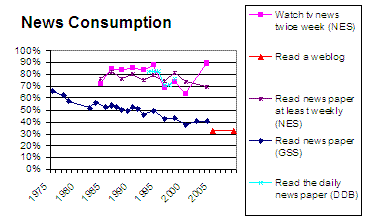Almost two centuries ago, Tocqueville detected a close relationship between journalism and civic engagement. Newspapers were the main news organs of his day, and he wrote that “hardly any democratic association can do without” them. “There is a necessary connection between public associations and newspapers: newspapers make associations and associations make newspapers; and if it has been correctly advanced that associations will increase in number as the conditions of men become more equal, it is not less certain that the number of newspapers increases in proportion to that of associations. Thus it is in America that we find at the same time the greatest number of associations and of newspapers.”
I wanted to see whether the relationship that Tocqueville observed impressionistically remains true. Yesterday, using the 2000 American National Election Study, I found strong, statistically significant relationships between people’s frequency of reading a newspaper, on one hand, and their likelihood of volunteering, working on a community issue, attending a community meeting, contacting public officials, belonging to organizations, and belonging to organizations that influence the schools (but not protesting or belonging to an organization that influences the government). To illustrate these relationships with an example: 42.4 percent of daily newspaper readers belonged to at least one association, compared to 19.4 percent of people who read no issues of a newspaper in a typical week.
I did not control for other factors, such as education. Nevertheless, it appears that residents who engage in their communities also seek information from a high-quality source–and vice-versa. Having information about current events gives one relevant facts and motives to participate; and participation leads one to seek information.
Rates of newspaper reading have fallen sharply. I realize there is nothing sacrosanct about the printed daily newspaper; websites or radio and television broadcasts could, in theory, be just as good for civic engagement. But there is no evidence that the electronic media have yet compensated for the decline in newspaper consumption.

Hi from Flagstaff, Peter. As it happens, a colleague and I recently published a paper where we look at the relationship between this variable and participation in protest — another kind of civic engagement. Your post caught my eye because, in earlier drafts of the paper, we compared ANES data to the Citizen Participation Survey data. We eventually ended up dropping the ANES pieces of the paper, as the set of comparisons grew a little too complicated to carry through a relatively short (and reviewer-friendly) paper, but the Cit. Partic. data certainly shows a similar relationship between political/civic interest, organizational membership, and (in our case) protest.
If you’re interested, you can find the paper in the Dec. 2005 issue of Social Forces — or I’d be happy to send you a copy.
Thanks, Alan. Also, Dhavan Shah and colleagues have a paper that does control for background variables and finds a powerful relationship. Dhavan V. Shah, Nojin Kwak, and R. Lance Holbert,”?Connecting? and ?Disconnecting? with Civic Life: Patterns of Internet Use and the Production of Social Capital,? Political Communication, 18 (2): 141-162, Spring, 2001.